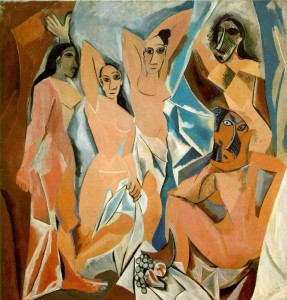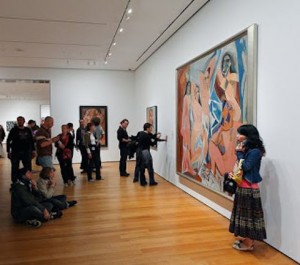Why you should see ‘Naked Problems’
 Pablo Picasso was the most dominant and influential artist of the first half of the twentieth century. Associated most of all with pioneering Cubism, he also invented collage and made major contributions to Symbolism and Surrealism. Famously charismatic, his many relationships with women not only filtered into his art but may have directed its course, and his behavior has come to embody that of the bohemian modern artist in the popular imagination.
Pablo Picasso was the most dominant and influential artist of the first half of the twentieth century. Associated most of all with pioneering Cubism, he also invented collage and made major contributions to Symbolism and Surrealism. Famously charismatic, his many relationships with women not only filtered into his art but may have directed its course, and his behavior has come to embody that of the bohemian modern artist in the popular imagination.
Picasso purposely avoided titling his artworks, and that is true of The Demoiselles of Avignon. When  he originally introduced the brazen painting at a private unveiling, the poets he associated with named the painting The Philosophical Brothel to lighten the mood of disappointment with which the work was met. But the title did not stick, and it was renamed Les Demoiselles d’Avignon in anticipation of the painting’s scandalous 1916 Paris début.
he originally introduced the brazen painting at a private unveiling, the poets he associated with named the painting The Philosophical Brothel to lighten the mood of disappointment with which the work was met. But the title did not stick, and it was renamed Les Demoiselles d’Avignon in anticipation of the painting’s scandalous 1916 Paris début.
Today, the painting is part of the permanent collection of the Museum of Modern Art in Manhattan, and the work’s gallery label states:
 “Les Demoiselles d’Avignon marks a radical break from traditional composition and perspective in painting. It depicts five naked women with figures composed of flat, splintered planes and faces inspired by Iberian sculpture and African masks. The compressed space the figures inhabit appears to project forward in jagged shards; a fiercely pointed slice of melon in the still life of fruit at the bottom of the composition teeters on an impossibly upturned tabletop. These strategies would be significant in Picasso’s subsequent development of Cubism, charted in this gallery with a selection of the increasingly fragmented compositions he created in this period.
“Les Demoiselles d’Avignon marks a radical break from traditional composition and perspective in painting. It depicts five naked women with figures composed of flat, splintered planes and faces inspired by Iberian sculpture and African masks. The compressed space the figures inhabit appears to project forward in jagged shards; a fiercely pointed slice of melon in the still life of fruit at the bottom of the composition teeters on an impossibly upturned tabletop. These strategies would be significant in Picasso’s subsequent development of Cubism, charted in this gallery with a selection of the increasingly fragmented compositions he created in this period.
 “Picasso unveiled the monumental painting in his Paris studio after months of revision. The Avignon of the work’s title is a reference to a street in Barcelona famed for its brothel. In Picasso’s preparatory studies for the work, the figure at the left was a man, but the artist eliminated this anecdotal detail in the final painting.”
“Picasso unveiled the monumental painting in his Paris studio after months of revision. The Avignon of the work’s title is a reference to a street in Barcelona famed for its brothel. In Picasso’s preparatory studies for the work, the figure at the left was a man, but the artist eliminated this anecdotal detail in the final painting.”
B ut sculptor AR Kara contends that this and the other reviews of Les Demoiselles d’Avignon that have been rendered over the years fail to reveal the painting’s true meaning and significance. In his 15-minute short film, Naked Problems, Kara claims to have solved the riddle of this famous painting.
ut sculptor AR Kara contends that this and the other reviews of Les Demoiselles d’Avignon that have been rendered over the years fail to reveal the painting’s true meaning and significance. In his 15-minute short film, Naked Problems, Kara claims to have solved the riddle of this famous painting.
“The Brothel and Demoiselles titles tacitly cast the painting’s five nudes as a group scene. They set an interpretive course (titles often do) that remained unquestioned, even as the enigmatic painting’s early infamy turned to influence and then worldwide awe,” writes Kara on the website he’s created for the film. (Please visit http://www.nakedproblems.com.)
 According to the film, Picasso did not intend Les Demoiselles d’Avignon as a group composition, but rather as a blatant and unabashed seduction in which each of the figures creates a separate and distinct relationship with the viewer through movement and time. “Naked Problems bares this seduction’s iconic drama,” claims the filmmaker.
According to the film, Picasso did not intend Les Demoiselles d’Avignon as a group composition, but rather as a blatant and unabashed seduction in which each of the figures creates a separate and distinct relationship with the viewer through movement and time. “Naked Problems bares this seduction’s iconic drama,” claims the filmmaker.
 Kara introduces a siren’s silhouette into the painting to uncover its demoiselle by demoiselle seductive content along with spirited music performed with brio by acclaimed virtuosos Angele Dubeau and La Pieta. Then, as the music fades, an off-stage bard removes each demoiselle’s art mask to reveal “every boldly painted but never-before-noted attitude, nuance and emotion.” This segment
Kara introduces a siren’s silhouette into the painting to uncover its demoiselle by demoiselle seductive content along with spirited music performed with brio by acclaimed virtuosos Angele Dubeau and La Pieta. Then, as the music fades, an off-stage bard removes each demoiselle’s art mask to reveal “every boldly painted but never-before-noted attitude, nuance and emotion.” This segment  of the film also focuses on the painting’s skewed perspective and props, such as the impossibly upturned table and priapic fruit mentioned in the MoMA gallery label … along with “the critical till-now-unrecognized curtain billowing in its lower right corner.”
of the film also focuses on the painting’s skewed perspective and props, such as the impossibly upturned table and priapic fruit mentioned in the MoMA gallery label … along with “the critical till-now-unrecognized curtain billowing in its lower right corner.”
As the music cascades back in, the film makes “the long-surmised leap from the revolutionary Demoiselles to Cubism – briskly, simply and for the first time.”
 Had distinguished critics and historians been aware of the painting’s Brothel title, filmmaker Kara speculates, “the unifying principle in Naked Problems would have stood out long ago, resolving The Demoiselles of Avignon, redefining Cubism and magnifying our amazement at the depth, speed and wit of Picasso’s eye and hand.”
Had distinguished critics and historians been aware of the painting’s Brothel title, filmmaker Kara speculates, “the unifying principle in Naked Problems would have stood out long ago, resolving The Demoiselles of Avignon, redefining Cubism and magnifying our amazement at the depth, speed and wit of Picasso’s eye and hand.”
But Kara has one final surprise. But for that, you’ll  just have to see the film.
just have to see the film.
Naked Problems was written, produced & directed by sculptor AR Kara, with stage veteran Richard Grusin voicing Pablo Picasso and dancer Mary Kay Lee as the Siren. The Camille Saint-Saëns’ spirited Dance macabre is performed by renowned virtuosos Angèle Dubeau & La Pietà.
RELATED POSTS.
- Overview of the 7th Annual Fort Myers Film Festival
- What writer-director-sculptor AR Kara has to say about ‘Naked Problems’
- Why you should see ‘Paradise Reef’
- Meet ‘Paradise Reef’ writer and director John Scoular
- A word or two about Everglades fine art photographer Clyde Butcher
- Meet ‘Paradise Reef’ cinematographer and commentator Andy Brandy Casagrande IV
- A look back at John Scoular documentary ‘Marcus Jansen: Examine & Report’
 Lake O discharge documentary, ‘Black Tide,’ to open Fort Myers Film Festival
Lake O discharge documentary, ‘Black Tide,’ to open Fort Myers Film Festival- Meet ‘Black Tide’ writer, director and producer Steven Johnson
- Read what ‘Black Tide’ filmmaker Steven Johnson has to say about his documentary
- How the Everglades, Caloosahatchee and St. Lucie got so bad
 Why you should see ‘Bubbles’
Why you should see ‘Bubbles’- How ‘Bubbles’ got made
- Meet ‘Bubbles’ screenwriter and maniacal clown Cesar Aguilera
- Why you should see ‘The Radical Jew’
- ‘Radical Jew’ awards and accolades
- Why you should see ‘The Stairs’
- Why the filmmakers made ‘The Stairs’
- Why you should see ‘Three Wishes’ at this year’s Fort Myers Film Festival
- Meet ‘Three Wishes’ writer, director and producer Curtis Collins















 Tom Hall is both an amateur artist and aspiring novelist who writes art quest thrillers. He is in the final stages of completing his debut novel titled "Art Detective," a story that fictionalizes the discovery of the fabled billion-dollar Impressionist collection of Parisian art dealer Josse Bernheim-Jeune, thought by many to have perished during World War II when the collection's hiding place, Castle de Rastignac in southern France, was destroyed by the Wehrmacht in reprisal for attacks made by members of the Resistance operating in the area. A former tax attorney, Tom holds a bachelor's degree as well as both a juris doctorate and masters of laws in taxation from the University of Florida. Tom lives in Estero, Florida with his fiancee, Connie, and their four cats.
Tom Hall is both an amateur artist and aspiring novelist who writes art quest thrillers. He is in the final stages of completing his debut novel titled "Art Detective," a story that fictionalizes the discovery of the fabled billion-dollar Impressionist collection of Parisian art dealer Josse Bernheim-Jeune, thought by many to have perished during World War II when the collection's hiding place, Castle de Rastignac in southern France, was destroyed by the Wehrmacht in reprisal for attacks made by members of the Resistance operating in the area. A former tax attorney, Tom holds a bachelor's degree as well as both a juris doctorate and masters of laws in taxation from the University of Florida. Tom lives in Estero, Florida with his fiancee, Connie, and their four cats.